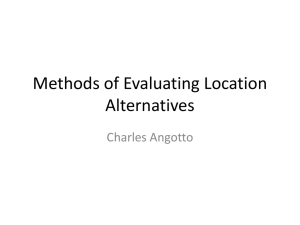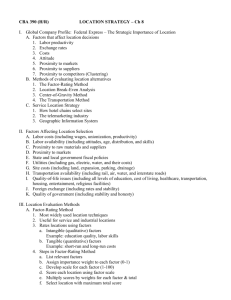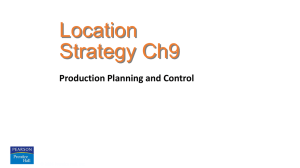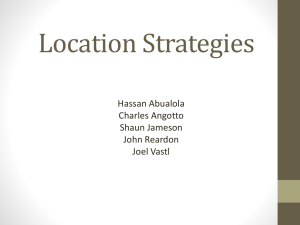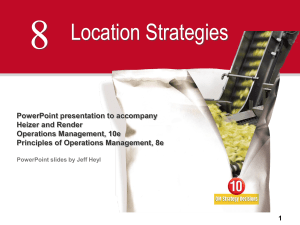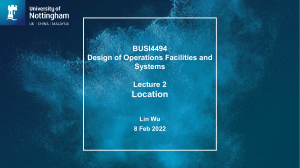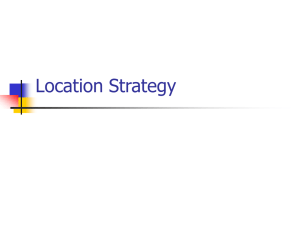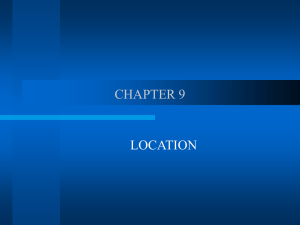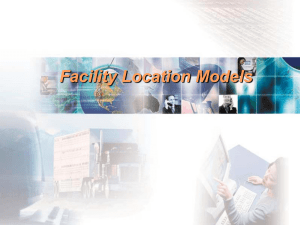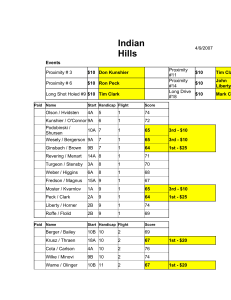POM LECT 11 ver 2
advertisement
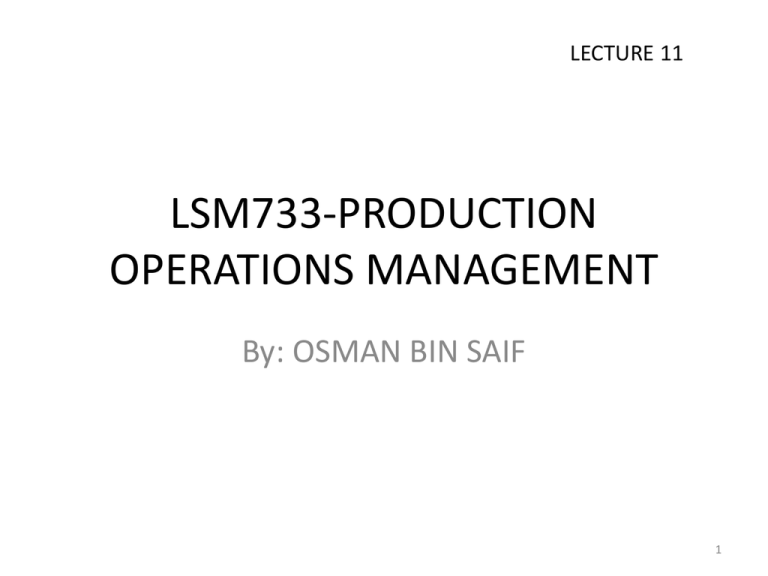
LECTURE 11 LSM733-PRODUCTION OPERATIONS MANAGEMENT By: OSMAN BIN SAIF 1 Summary of last session Four Process Strategies Process Focus Repetitive Focus Product Focus Mass Customization Focus Comparison of Process Choices Process Analysis and Design Flow Diagrams Time-Function Mapping Value-Stream Mapping Process Charts Service Blueprinting 2 Summary of last session (Contd.) Service Process Design Customer Interaction and Process Design More Opportunities to Improve Service Processes Selection of Equipment and Technology Production Technology Machine Technology Automatic Identification Systems (AISs) and RFID Process Control Vision Systems Robots 3 Summary of last session (Contd.) Production Technology (cont.) Automated Storage and Retrieval Systems (ASRSs) Automated Guided Vehicles (AGVs) Flexible Manufacturing Systems (FMSs) Computer-Integrated Manufacturing (CIM) Technology in Services Process Redesign Ethics and Environmentally Friendly Processes 4 Agenda for this Session Global Company Profile: FedEx The Strategic Importance of Location 5 Agenda for this Session (Contd.) Factors That Affect Location Decisions Labor Productivity Exchange Rates and Currency Risks Costs Political Risk, Values, and Culture Proximity to Markets Proximity to Suppliers Proximity to Competitors (Clustering) 6 Agenda for this Session (Contd.) Methods of Evaluating Location Alternatives The Factor-Rating Method Locational Break-Even Analysis Center-of-Gravity Method Transportation Model 7 Agenda for this Session (Contd.) Service Location Strategy How Hotel Chains Select Sites The Call Center Industry Geographic Information Systems 8 Chapter : Location Decision 9 Location Strategy The objective of location strategy is to maximize the benefit of location to the firm 10 Location Strategy One of the most important Long-term decision a firm makes. Once committed to a location, many resource and cost issues are difficult to change Decisions made relatively infrequently Increasingly global in nature (FedEx- a hub in China, Hard Rock Cafe – Moscow) Significant impact on fixed and variable costs (may include as much as 50% of total cost) The objective is to maximize the benefit of location to the firm 11 Location and Costs Location decisions supporting a low cost competitive strategy require careful consideration Because once in place, location-related costs are fixed in place and difficult to reduce Regions with high energy cost, expensive, illtrained human resource with poor work ethics will make a location decision supporting a low cost competitive strategy UNSUCCESFUL. 12 Location and Innovation Cost is not always the most important aspect of a strategic decision. For some companies the focus on cost may change to the focus on innovation, creativity and research. For instance Intel prefered to open its newest plant in Arizona where education levels are high and skilled labor is abundant. Moreover, this strategy gave them the advantage of protection of intellectual property in the U.S. 13 Federal Express Central hub concept Enables service to more locations with fewer aircraft Enables matching of aircraft flights with package loads Reduces mishandling and delay in transit because there is total control of packages from pickup to delivery 14 Location Decisions Country Decision Key Success Factors 1. Political risks, government rules, attitudes, incentives 2. Cultural and economic issues 3. Location of markets 4. Labor talent, attitudes, productivity, costs 5. Availability of supplies, communications, energy 6. Exchange rates and currency risks Figure 8.1 15 Location Decisions Region/ Community Decision MN WI MI IL IN OH Key Success Factors 1. Corporate desires 2. Attractiveness of region 3. Labor availability and costs 4. Costs and availability of utilities 5. Environmental regulations 6. Government incentives and fiscal policies 7. Proximity to raw materials and customers 8. Land/construction costs Figure 8.1 16 Location Decisions Site Decision Key Success Factors 1. Site size and cost 2. Air, rail, highway, and waterway systems 3. Zoning restrictions 4. Proximity of services/ supplies needed 5. Environmental impact issues Figure 8.1 17 Global Competitiveness Index 2010–2011-2012. Country/Economy Switzerland Sweden Singapore United States Germany Japan Finland Denmark Canada United Kingdom France China Spain Portugal Turkey Bulgaria 2010 - 2011 1 2 3 4 5 6 7 9 10 12 15 27 42 46 61 71 2011 - 2012 1 3 2 5 6 9 7 8 12 10 18 26 36 45 59 74 18 Labor Productivity Affects Total Cost Labor productivity Wage rates are not the only cost Lower productivity may increase total cost Labor cost per day Productivity (units per day) Connecticut $70 = $1.17 per unit 60 units = Cost per unit Juarez, Mexico $25 = $1.25 per unit 20 units 19 Ethical Issues • Location decisions based on costs alone can create difficult ethical situations. Some News from International Media: • At least eleven 15-year-old children were discovered to be working last year in three factories which supply Apple. • Computer giant Apple admitted that child labor was used in three supplier factories in 2009 to build iPhones, iPods and Macintosh computers. 20 Seven Factors That Affect Location Decisions 1. Labor productivity 2. Exchange rates and currency risks 3. Costs (Tangible such as utilities, labor, materials, taxes and Intangible qualityof-life, education level) 4. Political risk, values, and culture, ethics 5. Proximity to markets 6. Proximity to suppliers 7. Proximity to competitors (Clustering) 21 Factors That Affect Location Decisions Labor productivity Wage rates are not the only cost Lower production may increase total cost Labor cost per day Production (units per day) = Cost per unit Connecticut Juarez $70 = $1.17 per unit 60 units $25 = $1.25 per unit 20 units 22 Factors That Affect Location Decisions Exchange rates and currency risks Can have a significant impact on cost structure Rates change over time Costs Tangible - easily measured costs such as utilities, labor, materials, taxes Intangible - less easy to quantify and include education, public transportation, community, quality-of-life 23 Factors That Affect Location Decisions Exchange rates and currency risks Can have a significant impact on cost structure Location decisions based on costs alone Costs create difficult Tangible - easily measured can costs such as utilities, labor, materials, taxes ethical situations Rates change over time Intangible - less easy to quantify and include education, public transportation, community, quality-of-life 24 Factors That Affect Location Decisions Political risk, values, and culture National, state, local governments attitudes toward private and intellectual property, zoning, pollution, employment stability may be in flux Worker attitudes towards turnover, unions, absenteeism Globally cultures have different attitudes towards punctuality, legal, and ethical issues 25 Ranking Corruption Rank Country 1 New Zealand 2 Denmark, Finland 3 Sweden 4 Singapore 6 Norway 12 Hong Kong 14 Germany, Japan 17 UK 24 USA 41 Poland 43 South Korea 57 Saudi Arabia 61 Turkey 143 Russia 182 Somalia 2011 CPI Score (out of 10) 9.5 Least Corrupt 9.4 9.3 9.2 9.0 8.4 8.0 7.8 7.1 5.5 5.4 4.7 Most 4.2 Corrupt 2.4 1.0 26 Factors That Affect Location Decisions Proximity to markets Very important to services JIT systems or high transportation costs may make it important to manufacturers Proximity to suppliers Perishable goods, high transportation costs, bulky products 27 Factors That Affect Location Decisions Proximity to competitors Called clustering Often driven by resources such as natural, information, capital, talent Found in both manufacturing and service industries 28 Clustering of Companies Industry Locations Reason for clustering Wine making Napa Valley (US) Bordeaux region (France) Natural resources of land and climate Software firms Silicon Valley, Boston, Bangalore (India) Talent resources of bright graduates in scientific/technical areas, venture capitalists nearby Race car builders Huntington/North Hampton region (England) Critical mass of talent and information Table 8.3 29 Clustering of Companies Industry Locations Reason for clustering Theme parks (Disney World, Universal Studios) Orlando, Florida A hot spot for entertainment, warm weather, tourists, and inexpensive labor Electronics firms Northern Mexico NAFTA, duty free export to US Computer hardware manufacturers Singapore, Taiwan High technological penetration rate and per capita GDP, skilled/educated workforce with large pool of engineers Table 8.3 30 Clustering of Companies Industry Fast food chains (Wendy’s, McDonald’s, Burger King, and Pizza Hut) Locations Sites within 1 mile of each other Reason for clustering Stimulate food sales, high traffic flows General aviation Wichita, Kansas aircraft (Cessna, Learjet, Boeing) Mass of aviation skills Orthopedic device manufacturing Ready supply of skilled workers, strong U.S. market Warsaw, Indiana Table 8.3 31 Factor-Rating Method Popular because a wide variety of factors including both qualitative and quantitative can be included in the analysis. Six steps in the method are: 1. Develop a list of relevant factors called key success factors 2. Assign a weight to each factor 3. Develop a scale for each factor 4. Score each location for each factor 5. Multiply score by weights for each factor for each location 6. Recommend the location with the highest point score 32 Factor-Rating Example Key Success Factor Labor availability and attitude People-tocar ratio Per capita income Tax structure Education and health Totals Weight Scores (out of 100) France Denmark Weighted Scores France Denmark .25 70 60 (.25)(70) = 17.5 (.25)(60) = 15.0 .05 50 60 (.05)(50) = 2.5 (.05)(60) = 3.0 .10 .39 85 75 80 70 (.10)(85) = 8.5 (.39)(75) = 29.3 (.10)(80) = 8.0 (.39)(70) = 27.3 .21 60 70 (.21)(60) = 12.6 (.21)(70) = 14.7 70.4 68.0 1.00 Table 8.4 33 Locational Break-Even Analysis Method of cost-volume analysis used for industrial locations Three steps in the method 1. Determine fixed and variable costs for each location 2. Plot the cost for each location 3. Select location with lowest total cost for expected production volume 34 Locational Break-Even Analysis Example Three locations: Selling price = $120 Expected volume = 2,000 units City Fixed Cost Akron Bowling Green Chicago $30,000 $60,000 $110,000 Variable Cost $75 $45 $25 Total Cost $180,000 $150,000 $160,000 Total Cost = Fixed Cost + (Variable Cost x Volume) 35 Annual cost Locational Break-Even Analysis Example Figure 8.2 – $180,000 – – $160,000 – $150,000 – – $130,000 – – $110,000 – – – $80,000 – – $60,000 – – – $30,000 – – $10,000 – | – 0 Akron lowest cost Chicago lowest cost Bowling Green lowest cost | | | | | | 500 1,000 1,500 2,000 2,500 3,000 Volume 36 Center-of-Gravity Method Finds location of a distribution center that minimizes distribution costs Considers Location of markets Volume of goods shipped to those markets Shipping cost (or distance) 37 Center-of-Gravity Method Place existing locations on a coordinate grid Grid origin and scale is arbitrary Maintain relative distances Calculate X and Y coordinates for ‘center of gravity’ Assumes cost is directly proportional to distance and volume shipped 38 Center-of-Gravity Method ∑dixQi x - coordinate = i ∑Qi i ∑diyQi y - coordinate = i ∑Qi i where dix = diy = Qi = x-coordinate of location i y-coordinate of location i Quantity of goods moved to or from location i 39 Center-of-Gravity Method North-South New York (130, 130) Chicago (30, 120) 120 – Pittsburgh (90, 110) 90 – 60 – 30 – – | Arbitrary origin Atlanta (60, 40) | | | | | 30 60 90 120 150 East-West Figure 8.3 40 Center-of-Gravity Method Store Location Chicago (30, 120) Pittsburgh (90, 110) New York (130, 130) Atlanta (60, 40) Number of Containers Shipped per Month 2,000 1,000 1,000 2,000 (30)(2000) + (90)(1000) + (130)(1000) + (60)(2000) x-coordinate = 2000 + 1000 + 1000 + 2000 = 66.7 (120)(2000) + (110)(1000) + (130)(1000) + (40)(2000) y-coordinate = 2000 + 1000 + 1000 + 2000 = 93.3 41 Center-of-Gravity Method North-South New York (130, 130) Chicago (30, 120) 120 – Pittsburgh (90, 110) + 90 – Center of gravity (66.7, 93.3) 60 – 30 – – | Arbitrary origin Atlanta (60, 40) | | | | | 30 60 90 120 150 East-West Figure 8.3 42 Transportation Model Finds amount to be shipped from several points of supply to several points of demand Solution will minimize total production and shipping costs A special class of linear programming problems 43 Service Location Strategy Service sector focuses on maximizing revenue. The most important factors affecting location decisions in service industry are: 1. Purchasing power of customer-drawing area 2. Demographics of the customer-drawing area 3. Competition in the area 4. Physical qualities of facilities and neighboring businesses 44 Worldwide Distribution of Volkswagens and Parts Figure 8.4 45 Location Strategies Service/Retail/Professional Location Goods-Producing Location Revenue Focus Cost Focus Volume/revenue Drawing area; purchasing power Competition; advertising/pricing Physical quality Parking/access; security/lighting; appearance/image Cost determinants Rent Operations policies (hours, wage rates) Tangible costs Transportation cost of raw material Shipment cost of finished goods Energy and utility cost; labor; raw material; taxes, and so on Intangible and future costs Attitude toward union Quality of life Education expenditures by state Quality of state and local government Table 8.6 46 Location Strategies Service/Retail/Professional Location Techniques Regression models to determine importance of various factors Factor-rating method Traffic counts Demographic analysis of drawing area Purchasing power analysis of area Center-of-gravity method Geographic information systems Goods-Producing Location Techniques Transportation method Factor-rating method Locational break-even analysis Crossover charts Table 8.6 47 Location Strategies Service/Retail/Professional Location Assumptions Goods-Producing Location Assumptions Location is a major determinant of revenue High customer-contact issues are critical Costs are relatively constant for a given area; therefore, the revenue function is critical Location is a major determinant of cost Most major costs can be identified explicitly for each site Low customer contact allows focus on the identifiable costs Intangible costs can be evaluated Table 8.6 48 How Hotel Chains Select Sites Location is a strategically important decision in the hospitality industry La Quinta started with 35 independent variables and worked to refine a regression model to predict profitability The final model had only four variables Price of the inn Median income levels State population per inn Location of nearby colleges r2 = .51 51% of the profitability is predicted by just these four variables! 49 The Call Center Industry Requires neither face-to-face contact nor movement of materials Has very broad location options Traditional variables are no longer relevant Cost and availability of labor may drive location decisions Low-wage countries like India with highly educated, English-speaking work force have been attractive places for big U.S. Companies to hire call center staff. 50 Geographic Information Systems (GIS) Important tool to help in location analysis Enables more complex demographic analysis Available data bases include Detailed census data Detailed maps Utilities Geographic features Locations of major services 51 Geographic Information Systems (GIS) 52 Summary of this Session Global Company Profile: FedEx The Strategic Importance of Location 53 Summary of this Session (Contd.) Factors That Affect Location Decisions Labor Productivity Exchange Rates and Currency Risks Costs Political Risk, Values, and Culture Proximity to Markets Proximity to Suppliers Proximity to Competitors (Clustering) 54 Summary of this Session (Contd.) Methods of Evaluating Location Alternatives The Factor-Rating Method Locational Break-Even Analysis Center-of-Gravity Method Transportation Model 55 Summary of this Session (Contd.) Service Location Strategy How Hotel Chains Select Sites The Call Center Industry Geographic Information Systems 56 THANK YOU 57
